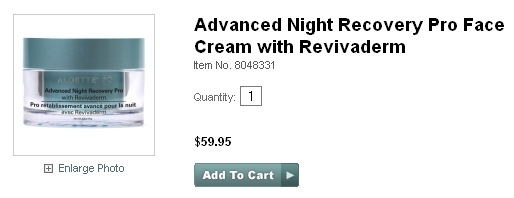Yesterday we discussed the first rule for a skin care product review and toward we talk about a second important “rule” – rule, that is, if you’re concerned about safety and your health. So, the second consideration when making a skin care product review is knowing your ingredients. Evaluating the safety of cosmetic products is a ‘must’ for safety and it isn’t hard to do. It just takes some time. For example, here is an Alouette skin care product:

Alouette states “Aloette does NOT test its products on animals.” That’s excellent and we applaud that decision 100%. However, the ingredients in this Alouette skin care cream aren’t so friendly – to humans. Here are some of their ingredients.
Cetyl Alcohol: all alcohol is drying to the skin; it is frequently obtained from whales or dolphins and unless we know the source, we cannot assume it is plant-based; there are some concerns about irritation of the skin, eyes or lungs
Peg-100 Stearate & Peg-10 Rapeseed Sterol: PEGs are used to thicken skin care products – yet they’re so strong that they’re often used in spray-on oven cleaners! PEGs can destroy the natural functioning of your skin which help keep it soft and moist. PEG products are likely to be contaminated with 1,4-dioxane, a carcinogen and research has clearly revealed that dioxane easily penetrates the skin.
Glycerine: if you’re concerned about healthy skin care, only used plant derived glycerin, not animal glycerine. It has been implicated as a carcinogen, developmental and reproductive toxicity, organ system toxicity as well as endocrine disruption. Glycerine can be sticky and since it is a “polyhydric alcohol” it can certainly be drying.
Hydroxyethylcellulose: irriation to skin, eyes or lungs; linked to developmental and reproductive toxicity which can range from infertility and reproductive organ cancers to birth defects and developmental delays for children; possible links to harm to the brain and nervous system.
Methylparaben & Propylparaben: Used as inhibitors of microbial growth and to extend shelf life of products. Widely used even though they are known to be toxic. Have caused many allergic reactions and skin rashes. Highly toxic. {From Material Safety Data Sheet (MSDS)}: “WARNING! HARMFUL IF SWALLOWED OR INHALED. CAUSES IRRITATION TO SKIN, EYES AND RESPIRATORY TRACT. MAY CAUSE ALLERGIC SKIN REACTION. SKIN CONTACT: CAUSES IRRITATION TO SKIN. SYMPTOMS INCLUDE REDNESS, ITCHING, AND PAIN. MAY CAUSE ALLERGIC SKIN REACTIONS. EYE CONTACT: CAUSES IRRITATION, REDNESS, AND PAIN.” It’s estimated that 13,200 cosmetic and skin care products contain parabens and the number is growing astronomically because they’re cheap to manufacture. Methyl paraben may degrade releasing methanol, a potentially toxic chemical. Studies implicate their connection with cancer. They have hormone-disrupting qualities – mimicking estrogen – and interfere with the body’s endocrine system. According to the Journal of Applied Toxicology, they have been implicated in cancers because they increase estrogenic activity in the body. They have caused many allergic reactions and skin rashes. They are effective preservatives because they inhibit enzyme activity – but the human body desperately needs enzymes. Research has shown that they may affect the future fertility of male babies. According to Professor John Sumpter of Brunel University, England, an expert on estrogenic chemicals in the environment, the use of these preservatives might just “play a role in falling sperm counts and rising breast cancer rates.”
Ammonium Acryloyldimethyltaurate: linked to cancer, developmental toxicity, reproductive toxicity, allergies, immunotoxicity and irritation of the skin, eyes or lungs
Propylene Glycol: A cosmetic form of mineral oil found in automatic brake and hydraulic fluid and industrial antifreeze. In skin and hair products, propylene glycol works as a humectant, which is a substance that retains the moisture content of skin or cosmetic products by preventing the escape of moisture or water. The MSDS warn users to avoid skin contact with propylene glycol as this strong skin irritant can cause liver abnormalities and kidney damage.
Disodium EDTA: Known to be cytotoxic and genotoxic to animals, used to remove calcium from the blood, links to cancer, neurotoxicity, organ system toxicity. Disodium EDTA is a “penetration enhancer’, meaning it causes alterations in the skin that allow other chemicals to penetrate deeper into the skin so it’s used as a thickener and penetration enhancer. It alters the skin’s structure, increasing the amount of other chemicals that reach the blood stream. It may cause rashes, allergies, asthma, irritation to mucous membranes, numbness; headache, toxic skin and mucous membrane reactions, nausea, vomiting, diarrhea, anemia and electrolyte imbalances. It has also been tied to kidney damage.
Diazolidinyl Urea: is a form of formaldehyde! Yes, the stuff that is used to preserve dead people. Diazolidinyl Urea is “reasonably anticipated to be a human carcinogen,” according to the National Toxicology Program’s “Ninth Report on Carcinogens” and the EPA classifies it as a “probable human carcinogen”. It can be absorbed through the skin and nails. In spite to this, it’s found in MANY cosmetics. Be aware that many products don’t list formaldehyde as such, but will include the following, which then break down into formaldehyde: diazolidinyl urea (or 3-diol diazolidinyl urea), 2-bromo-2-nitropropane-1 (or bronopol), DMDM hydantoin, imidazolidinyl urea & quaternium-15.
Iodopropynyl Butylcarbamate: is prohibited for use in cosmetics in the European Union & is supposedly not supposed to be used in the US (?); linked to cancer, allergies, immunotoxicity, irritation of the skin, eyes or lungs; organ system toxicity; endocrine disruption; neurotoxicity ranging from subtle developmental delays to chronic nerve degeneration diseases.
Yes, these horrors are indeed in some of the ingredients in Alouette’s expensive products and it’s obvious that these are NOT human friendly, which brings us to …
SKIN CARE PRODUCT REVIEW RULE #2: Pay very close attention to your ingredients!
Leave a Reply